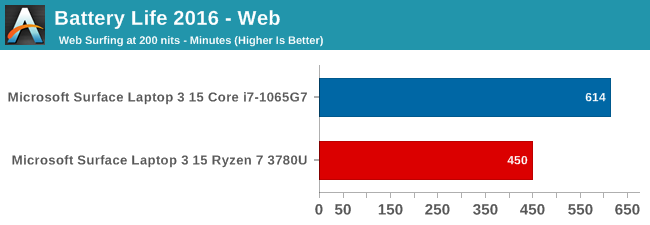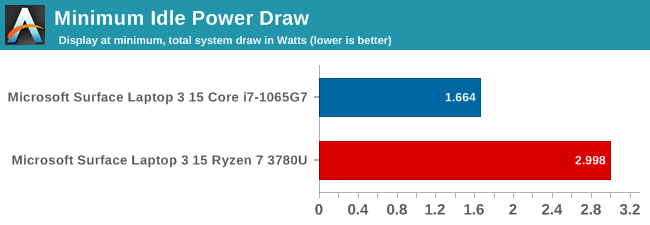The Microsoft Surface Laptop 3 Showdown: AMD's Ryzen Picasso vs. Intel's Ice Lake
by Brett Howse & Andrei Frumusanu on December 13, 2019 8:30 AM ESTPlatform Power
Performance aside, the other side of the coin is battery life. AMD made big gains in battery life with the Ryzen 3000 series, somewhat addressing the power requirements of the platform and getting rid of some of the excessive idle power draw, but they are still using DDR4 on their mobile platform, which puts them at a disadvantage right out of the gate. Intel has made very good gains in battery life over the last several generations, and the move to 10 nm for Ice Lake also brought along LPDDR4X support. Most of the previous generation laptops stuck with LPDDR3, unless the manufacturer needed more than 16 GB of RAM, where they’d be forced to switch to DDR4. Finally adding LPDDR4X support is something that Intel has needed to do for a while, and ironically Intel’s flagship Core product line lagged behind their low-cost Atom lineup which did support LPDDR4.
Web Battery Life

The Ryzen 7 3780U powered Surface Laptop 3 was slightly under the Ryzen 5 device we tested at launch, but still in the same range. The AMD system isn’t helped very much by Microsoft only offering a 46 Wh nominal battery capacity, which is rather undersized for a 15-inch laptop. The Ice Lake device, as we’ve seen before, was much more efficient under load, offering a sizeable battery life lead.
Idle Power
One of AMD’s biggest challenges was to get their laptop SoC into a premium device, and with the Surface Laptop 3 they have succeeded. Microsoft has shown themselves as being adept at squeezing battery life out of devices, with low-power displays, and good internal components to minimize power draw. Here Intel has held a considerable advantage over the last couple of years, and the move to 10 nm should, in theory, help as well.
To test the idle power draw of both systems, the battery discharge rate was monitored with the screens fixed in at 5.35 nits, to minimize the power draw of the display on the result. Normally we’d prefer to have the display completely off for this test, but Microsoft’s power plan on the Surface Laptop actively turns off the laptop when the display times out.

The Ice Lake system was able to go all the way down to right around 2 Watts of power draw – and sometimes slightly under – with as low as 1.7 Watts seen. We’ve seen under 1 Watt of draw on an 8th generation Core Y series processor, and around 1.5 Watts on the same generation U series, so considering the display is not completely off on the Surface Laptop, the 2-Watt draw is quite reasonable.
The Picasso system was not quite as efficient, drawing 3 Watts at idle. This is in-line with the results we’ve seen on other Picasso systems and explains the lower battery life results on the AMD system. AMD made big gains moving from Raven Ridge to Picasso, but I’m sure the team is looking forward to the 7 nm Zen 2 coming to their laptops, which we hope will address this further.










174 Comments
View All Comments
sheh - Thursday, December 19, 2019 - link
The x264 conclusion is wrong:"x264, was also run. Here we see that once again Ice Lake has a significant performance advantage"
In fact, combining the result for both passes it's:
AMD: 11.79 FPS
Intel: 11.03 FPS
peevee - Monday, December 23, 2019 - link
Laptop CPUs needed the efficiency gains of Zen 2, Navi and 7nm the most. AMD had obviously dropped the ball here.MBarton - Monday, December 30, 2019 - link
They didn't "drop the ball". AMD is still financially weak. They can't afford to waste 7nm on mobile parts, which have low profit margins. All their focus are on the highly profitable server market and very profitable high end desktop market. Hence why every new Zen release is strongly focus on SERVER and HEDT. After all the money Intel has thrown away trying to get 10nm to work, they're making very little money selling 10nm parts for low margin laptops.Aviraj_21 - Saturday, January 4, 2020 - link
nice